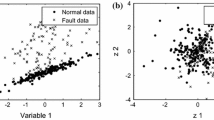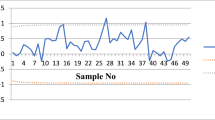Abstract
Many studies have been conducted over the past several years evaluating the integrated use of statistical process control (SPC) and engineering process control (EPC). The majority of these studies reported that combining SPC with EPC outperforms the use of only SPC or EPC. Basically, the former aims to rapidly detect assignable causes and time points for abnormalities that take place during process; and the latter is a method in which input variables are adjusted against process outputs through a feedback control mechanism. Although combining SPC with EPC can effectively detect time points when abnormalities occur during process, their combination can also cause an increased occurrence of false alarms when autocorrelation is present in the process. In this study, to increase the accuracy of process disturbance identification, we propose the integration of spatiotemporal independent component analysis (stICA) with the classification and regression tree (CART) approach to improve our capability to identify process disturbances and recognize shifts in the correlated process parameters. The integration of the CART methodology results in the development of decision rules that can provide valuable information related to the impact of variation in process variable values. These decision rules can provide an increased understanding of process behavior and useful information for process control. For comparison, the integration of traditional principle component analysis (PCA) with CART (called PCA-CART), ICA with CART (called ICA-CART) and cumulative sum chart approaches were applied to evaluate the identification capability of the proposed approach. As the results reveal, the proposed approach is more effective for monitoring correlated process.







Similar content being viewed by others
Explore related subjects
Discover the latest articles and news from researchers in related subjects, suggested using machine learning.References
Adams BM, Tseng LT (1998) Robustness of forecast-based monitoring schemes. J Qual Technol 30:328–329
Albazzaz H, Wang XZ (2007) Introduction of dynamics to an approach for batch process monitoring using independent component analysis. Chem Eng Commun 194:218–233
Alwan LC, Roberts HV (1988) Time series modeling for statistical process control. J Bus Econ Stat 6:87–95
Breiman L, Friedman JH, Olshen RA, Stone CJ (1984) Classification and regression trees. Wadsworth International Group, Belmont
Box GEP, Coleman DE, Baxley RV (1997) A comparison of statistical process control and engineering process control. J Qual Technol 29:128–130
Box GEP, Jenkins GM, Reinsel GC (1992) Time series analysis, forecasting, and control, 3rd edn. Prentice-Hall, Englewood Cliffs
Box GEP, Luceno A (1997) Statistical control by monitoring and feedback adjustment. Wiley, New York
Box GEP, Kramer T (1992) Statistical process monitoring and feedback adjustment—a discussion. Technometrics 34:251–285
Calhoun VD, Adali T, Pearlson GD, Pekar JJ (2001) Spatial and temporal independent component analysis of functional MRI data containing a pair of task-related waveforms. Hum Brain Mapp 13:43–53
Peng C, Qian X, Ye D (2007) Electrogastrogram extraction using independent component analysis with references. Neural Comput Appl 16(6):581–587
Cichocki A, Amari SI (2002) Adaptive blind signal and image processing: learning algorithms and applications. Wiley, New York
Comon P (1994) Independent component analysis: a new concept? Signal Process 36:287–314
David V, Sanchez A (2002) Frontiers of research in BSS/ICA. Neruocomputing 49:7–23
Faltin FW, Hahn GJ, Tucker WT, Vander Wiei SA (1993) Algorithmic statistical process control: some practical observations. Int Stat Rev 61:67–80
Ge ZQ, Song ZH (2007) Process monitoring based on independent component analysis-principal component analysis (ICA-PCA) and similarity factors. Ind Eng Chem Res 46:2054–2063
Hyvärinen A, Oja E (2000) Independent component analysis: algorithms and applications. Neural Netw 13:411–430
Hyvärinen A (1999) Fast and robust fixed-point algorithms for independent component analysis. IEEE Trans Neural Netw 10:626–634
Hyvarinen A (1998) Independent component analysis in the presence of Gaussian noise by maximizing joint likelihood. Neurocomputing 22:49–67
Hyvarinen A (1999) The fixed-point algorithm and maximum likelihood estimation for independent component analysis. Neural Process Lett 10:1–5
Hyvarinen A, Karhunen J, Oja E (2001) Independent component analysis. Wiley, New York
Hyvarinen A, Oja E (1997) A fast fixed-point algorithm for independent component analysis. Neural Comput 9:1483–1492
Kano M, Hasebe S, Hashimoto I (2003) Evolution of multivariate statistical process control: application of independent component analysis and external analysis. In: Proceedings of the foundations of computer aided process operations conference (FOCAPO 2003), Coral Spring, USA, pp 385–388
Kano M, Tanaka S, Hasebe S, Hashimoto I, Ohno H (2003) Monitoring independent components for fault detection. AIChE J 49:969–976
Lee TW (1998) Independent component analysis: theory and application. Kluwer, Boston
Lee JM, Yoo C, Lee IB (2004) Statistical process monitoring with independent component analysis. J Process Control 14(5):467–485
Lee JM, Yoo C, Lee IB (2003) On-line batch process monitoring using different unfolding method and independent component analysis. J Chem Eng Jpn 36:1384–1396
Lee JM, Yoo CK, Lee IB (2003) New monitoring technique with an ICA algorithm in the wastewater treatment process. Water Sci Technol 47(12):49–56
Lee JM, Yoo CK, Lee IB (2004) Statistical monitoring of dynamic processes based on dynamic independent component analysis. Chem Eng Sci 59:2995–3006
Lee JM, Qin SJ, Lee IB (2006) Fault detection and diagnosis based on modified independent component analysis. AIChE J 52:3501–3514
Lu CW, Reynolds MR Jr (1999) EWMA control charts for monitoring the mean of autocorrelated processes. J Qual Technol 31:166–188
Luceno A (1995) Choosing the EWMA parameter in engineering process control. J Qual Technol 27:162–168
Macgregor JF (1990) A different view of the funnel experiment. J Qual Technol 22:255–259
Macgregor JF (1988) On-line statistical process control. Chem Eng Prog 84:21–31
Macgregor JF, Harris TJ, Wright JD (1984) Duality between the control of processes subject to randomly occurring deterministic disturbances and ARIMA stochastic disturbances. Technometrics 26:389–397
Montgomery DC, Mastrangelo CM (1991) Some statistical process control for autocorrelation data. J Qual Technol 23(3):179–193
Montgomery DC, Keats JB, Runger GC, Messina WS (1994) Integrating statistical process control and engineering process control. J Qual Technol 26(2):79–87
Montgomery DC (2001) Introduction to statistical quality control, 4th edn. Wiley, New York
Shao YE (1998) Integrated application of the cumulative score control chart and engineering process control. Stat Sinica 8:239–252
Shao YE, Chiu CC (1999) Developing identification techniques with the integrated use of SPC/EPC and neural networks. Qual Reliab Eng Int 15:287–294
Shao YE, Runger GC, Haddock J, Wallace WA (1999) Adaptive controllers to integrate SPC and EPC. Commun Stat Simul Comput 28:13–36
Steinberg D, Colla P (1997) CART—classification and regression trees. Salford Systems, San Diego
Stone JV (2004) Independent component analysis: a tutorial introduction. MIT, Cambridge
Stone JV, Porrill J, Porter NR, Wilkinson ID (2002) Spatiotemporal independent component analysis of event-related fMRI data using skewed probability density functions. NeuroImage 15(2):407–421
He T, Clifford G, Tarassenko L (2006) Application of independent component analysis in removing artifacts from the electrocardiogram. Neural Comput Appl 15(2):105–116
Wieringa JE (1999) Statistical process control for serially correlated data. PhD dissertation. University of Groningen, Netherlands
Xia C, Howell J (2003) Isolating multiple sources of plant-wide oscillations via independent component analysis. Control Eng Pract 13(8):1027–1035
Xia C (2003) Control loop measurement based isolation of faults and disturbances in process plants. PhD thesis. University of Glasgow, UK
Yao ZX, Qian Y, Li XX, Jiang YB (2003) A description of chemical processes based on state space. In: Proceedings of the 8th international symposium on process systems engineering. Kunming, China, pp 1112–1117
Zhao CH, Wang FL, Mao ZY, Lu NY, Jia MX (2008) Adaptive monitoring based on independent component analysis for multiphase batch processes with limited modeling data. Ind Eng Chem Res 47:3104–3113
Acknowledgments
This research was partially supported by the National Science Council of the Republic of China under Grant Number NSC 95-2221-E-027-072-MY3.
Author information
Authors and Affiliations
Corresponding author
Rights and permissions
About this article
Cite this article
Chiu, CC., Hwang, SY., Cook, D.F. et al. Process disturbance identification through integration of spatiotemporal ICA and CART approach. Neural Comput & Applic 19, 677–689 (2010). https://doi.org/10.1007/s00521-009-0324-5
Received:
Accepted:
Published:
Issue Date:
DOI: https://doi.org/10.1007/s00521-009-0324-5




